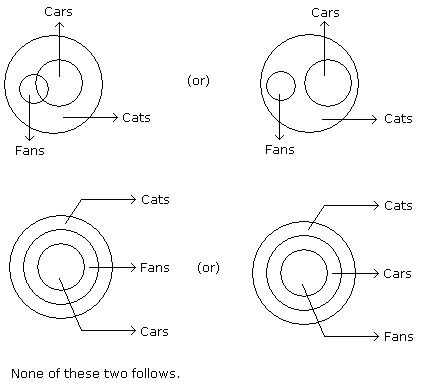Verbal Reasoning - Syllogism - Discussion
Discussion Forum : Syllogism - Syllogism 1 (Q.No. 14)
Directions to Solve
In each of the following questions two statements are given and these statements are followed by two conclusions numbered (1) and (2). You have to take the given two statements to be true even if they seem to be at variance from commonly known facts. Read the conclusions and then decide which of the given conclusions logically follows from the two given statements, disregarding commonly known facts.
Give answer:
- (A) If only (1) conclusion follows
- (B) If only (2) conclusion follows
- (C) If either (1) or (2) follows
- (D) If neither (1) nor (2) follows and
- (E) If both (1) and (2) follow.
14.
Statements: All cars are cats. All fans are cats.
Conclusions:
- All cars are fans.
- Some fans are cars.
Answer: Option
Explanation:

Discussion:
63 comments Page 1 of 7.
Pappitha said:
1 decade ago
D is the correct answer.
Indu said:
1 decade ago
D is the right since you itself check,it may or maynot be the fans are cats. so D is the answer.its right only
Amit said:
1 decade ago
Can please any body tell me, how will we come to know that we have to make more than 2 diagrams. ?
Srinu said:
1 decade ago
Please tel me the solution of the problem. Some same type question follow fig2 only but this question diferent how its posible please tel me.
Prabhu said:
1 decade ago
For possibilities are there. Statement should satify all the four. As per third diagram First statement follows but not for all the diagrams. As per third diagram second statement follows but not for all thats why the answer choice is D.
Reji said:
1 decade ago
Here middle term is ' cats '. As the middle term is not even distributed in one of the premises. Here is no conclusion.
Praveen srivastava said:
1 decade ago
Sillogism plobm is very confusion because manly two or more answer are correct so that situation we can draw many diagram and see them whose diffenrent then that is the right answer.
Resoning is very confusioning so problem is very common.
Only practise is that solution. So keep it up.
Resoning is very confusioning so problem is very common.
Only practise is that solution. So keep it up.
/>@\/@n said:
1 decade ago
'Either or' is used in sentences in a positive sense meaning "one or the other, this or that, he or she, etc."
'Neither nor' is used in sentences in a negative sense meaning "not this one nor the other, not this nor that, not he nor she, etc."
Apply this I hope you will get some clarity.
'Neither nor' is used in sentences in a negative sense meaning "not this one nor the other, not this nor that, not he nor she, etc."
Apply this I hope you will get some clarity.
Snehal said:
1 decade ago
@Amit, if there is 'No' appear in conclusion you have to draw all the possibilities. And if not there is no need to draw more than 1 diagram. 1 diagram is sufficient To come to the answer.
Diana said:
1 decade ago
It satisfies both the statement by the 3rd fig. Then how we can know the correct one? it've more possibilities.
Post your comments here:
Quick links
Quantitative Aptitude
Verbal (English)
Reasoning
Programming
Interview
Placement Papers